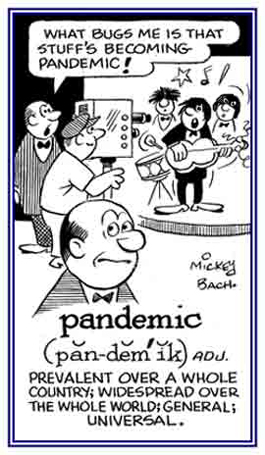pan-, panto-, pant-
(Greek: all, every, entire; always)
2. A proposed explanation intended to address a complex problem by trying to account for all possible contingencies but typically proving to be too broadly conceived and therefore oversimplified to be of any practical use.
2. Relating to something that is not restricted to a specific point in time: Since both Jim and Jill were retired, their vacation time could be panchronic, so they could choose any time to go on vacation!
2. A gland, situated near the stomach, that secretes a digestive fluid into the intestine through one or more ducts and also secretes the hormone insulin.
3. Etymology: literally, "entirely flesh"; a soft, fleshy, mallet-shaped organ that forms two different glandular elements situated behind the stomach.
More Details about the Pancreas
The pancreas is a fish-shaped spongy grayish-pink organ about six inches (15 cm) long that stretches across the back of the abdomen, behind the stomach.
The head of the pancreas is on the right side of the abdomen and is connected to the duodenum (the first section of the small intestine). The narrow end of the pancreas, called the tail, extends to the left side of the body.
The pancreas makes juices and hormones, including insulin. The pancreatic juices are enzymes that help digest food in the small intestine. Insulin controls the amount of sugar in the blood.
As pancreatic juices are made, they flow into the main pancreatic duct. This duct joins the common bile duct, which connects the pancreas to the liver and the gallbladder. The common bile duct, which carries bile (a fluid that helps digest fat), connects to the small intestine near the stomach.
The pancreas is considered to be a compound gland. It is "compound" in the sense that it is composed of both exocrine and endocrine tissues.
The exocrine function of the pancreas involves the synthesis and secretion of pancreatic juices.
The endocrine function resides in the million or so cellular islands (the islets of Langerhans) embedded between the exocrine units of the pancreas. Beta cells of the islands secrete insulin, which helps control carbohydrate metabolism. Alpha cells of the islets secrete glucagon that counters the action of insulin.
The islets of Langerhans were named for Paul Langerhans, a German anatomist, 1847–1888. Langerhans discovered these cells during his studies for his doctorate at the Berlin Pathological Institute in 1869.
2. A comprehensive treatise on a subject.
Pandects are compilations of Roman law consisting of selected passages from the writings of the most authoritative of the older jurists, methodically arranged, prepared by Tribonian with the assistance of sixteen associates, under a commission from the emporor Justinian.
This work comprises fifty books, and is one of the four great works composing the Corpus Juris Civilis. It was first published in A.D. 533, when Justinian gave it the force of law.
2. Relating to illnesses that affect the majority of a population in a large region; such as, a disease that is widespread at the same time in many parts of the world: AIDS is currently considered to be a pandemic problem, but this term has also traditionally included such disorders as cholera, plague, and influenza. 3. Etymology: from 1666 which came from Greek pandemos, "pertaining to all people"; from pan-, "all" + demos, "people".

Go to this Word A Day Revisited Index
so you can see more of Mickey Bach's cartoons.
2. Etymology: from Greek pan-, "all, entirely" + demos, "people".
The modern use of pandemonium for “uproar, chaos; noisy and chaotic” came about in the mid-nineteenth century.
When capitalized, Pandemonium refers to the capital of Hell; and when it is written in lower case, it refers to “noisy and chaotic”.
2. Etymology: John Milton formed the word from the Greek prefix pan-, “all” and daimon, “demon”; hence, “place of all the demons”.2. In Greek mythology, the first mortal woman created by the gods, who was sent to earth with a jar (or box) full of evils with the purpose of avenging Prometheus' theft of fire.
Pandora opened the jar out of curiosity; therefore, releasing the evils (disease, labor, pain, and many others) into the world and although she tried to close the lid as quickly as she could, the only thing she could keep from escaping was hope.
2. Etymology: from French panegyrique, via Latin from Greek panegurikos, "of public assembly"; from pan, "all" + aguris, "assembly".


Go to this Word A Day Revisited Index
so you can see more of Mickey Bach's cartoons.
Related "all, every" word unit: omni-.


